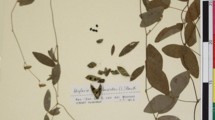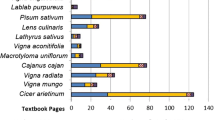Abstract
Here, we present new data on how to identify both the wild and domesticated forms of kañawa (Chenopodium pallidicaule Aellen) in the archeological record of Andean South America using characteristics of their seed morphology. The ability to identify both the domesticated and wild forms of kañawa is an essential step in advancing our understanding of the processes of its domestication, diversification, and the role it has played in past food systems throughout the Andes.
Resumen
Se presentan nuevos datos sobre la identificación arqueológica de las especies domesticadas y silvestres de kañawa (Chenopodium pallidicaule Aellen) utilizando características de la morfología de sus semillas. La capacidad de identificar las formas domesticadas y silvestres de kañawa es un paso clave para avanzar nuestra comprensión de los procesos de su domesticación, diversificación y entender su lugar en los sistemas alimentarios pasados de los Andes.






Similar content being viewed by others
Literature Cited
APG 1998. An ordinal classification for the families of flowering plants. Annals of the Missouri Botanical Garden 85: 531–553.
Browman, D. L. 1989. Chenopod cultivation, lacustrine resources, and fuel use at Chiripa, Bolivia. In New World Paleoethnobotany: Collected papers in honor of Leonard W. Blake, eds. E. E. Voigt and D. M. Pearsall, 137–172. Columbia, Missouri: Missouri Archaeological Society.
Bruno, M. C. 2001. Formative agriculture? The status of Chenopodium domestication and intensification at Chiripa, Bolivia (1500 B.C. - A.D.100). Master’s Thesis, Washington University in St. Louis.
———. 2006. A morphological approach to documenting the domestication of Chenopodium in the Andes. In Documenting domestication: New genetic and archaeological paradigms, eds. M. Zeder, D. Bradley, E. Emshwiller, and B.D. Smith, 32–45. Berkeley: University of California Press.
———. 2008. Waranq Waranqa: Ethnobotanical perspectives on agricultural intensification in the Lake Titicaca Basin (Taraco Peninsula, Bolivia). PhD Thesis, Washington University in St. Louis.
——— and W.T. Whitehead. 2003. Chenopodium cultivation and Formative period agriculture at Chiripa, Bolivia. Latin American Antiquity 14(3): 339–355.
Caló, Marilin. 2014. Archaeobotanical remains found in a house at the archaeological site of Cardonal, valle del Cajón, Argentina: A view of food practices 1800 years ago. Vegetation History and Archaeobotany 23(5):577–590.
Fritz, G.J., M.C. Bruno, B.S. Langlie, B.D. Smith, and L. Kistler, 2017 Cultigen chenopods in the Americas: A hemispherical perspective. In Social Perspectives on Ancient Lives from Paleoethnobotanical Data, eds. M.P. Sayre and M.C. Bruno, 55–76. Cham: Springer.
——— and B.D. Smith 1988. Old collections and new technology: Documenting the domestication of Chenopodium in eastern North America. Midcontinental Journal of Archaeology 13: 3–27.
Gade, D. W. 1970. Ethnobotany of cañihua (Chenopodium pallidicaule), rustic seed crop of the Altiplano. Economic Botany 24: 55–61.
Heiser, C. B. and D.C. Nelson. 1974. On the origin of cultivated chenopods (Chenopodium). Genetics 78: 503–505.
Hunziker, A. 1943. Las especies alimenticias de Amarantus y Chenopodium cultivadas por los indios de América. Revista Argentina Agronomica 10(2):146–154.
———. 1952. Los pseudocereales de la agricultura indígena de América. Buenos Aires: Acme.
IPGRI, PROINPA, and IFAD. 2005. Descriptores para cañahua (Chenopodium pallidicaule Aellen). La Paz, Bolivia: Fundación PROINPA.
Jellen, E. N., P.J. Maughan, F. Fuentes, and B. Kolano. 2014. Botánica, filogenia, y evolución. In Estado del arte de la quinua en el mundo en 2013, eds. D. Bazile, D. Bertero, and C. Nieto, 12–25. FAO and CIRAD: Santiago de Chile and Montpellier, France.
Langlie, B., C. A. Hastorf, M.C. Bruno, M. Bermann, R.M. Bonzani, and W. Castellón Condarco. 2011. Diversity in Andean Chenopodium domestication: Describing a new morphological type from La Barca, Bolivia, 1300-1250 B.C. Journal of Ethnobiology 31(1): 72–88.
National Research Council, Advisory Committee on Technology Innovation 1989. Lost crops of the Incas: Little-known plants of the Andes with promise for worldwide cultivation. Washington D.C.: National Academy Press.
Leon, J. 1964. Boletin Tecnico: Plantas alimenticias andinas, Vol 6. Lima: Instituto Interamericano de Ciencias Agricolas Zona Andina.
Pearsall, D. M. 1989. Adaptation of prehistoric hunter-gatherers in the high Andes: The changing role of plant resources. In Foraging and farming, eds. D. Harris and G. Hillman, 318–332. London: Unwin Hyman.
Pinto, M. 2011. Estudio de la variabilidad genética de la colección de germoplasma de cañahua (Chenopodium pallidicaule Aellen) de Bolivia. Master’s Thesis. Universidad Mayor de San Simón. Cochabamba.
Planella, M. T., M. L. López, and M.C. Bruno. 2014. La domesticación y distribución prehistórica. In Estado del arte de la quinua en el mundo en 2013, eds. D. Bazile, D. Bertero, and C. Nieto, 33–48. Santiago de Chile and Montpellier: FAO y CIRAD.
Planella, M.T. and B. Tagle. 2004. Inicios de presencia de cultígenos en la zona central de Chile, períodos arcaico y alfarero temprano. Chungara 36:387–399.
———, Cornejo B., L.E. and B. Tagle A. 2005. Alero Las Morrenas 1: Evidencia de Cultígenos entre Cazadores Recolectores de Finales del Período Arcaico en Chile Central. Chungara 37(1):59–74.
Planchuelo, A.M. 1975. Estudio de los frutos y semillas del género Chenopodium en la Argentina. Darwiniana 19(2–4):528–565.
Risi, J., and N.W. Galwey. 1984. The Chenopodium grains of the Andes: Inca crops for modern agriculture. Advances in Applied Biology 10:145–216.
Rojas, W., JL Soto, M. Pinto, M. Jäger, and M. Padulosi. 2010. Granos Andinos: Avances, logros y experiencias desarrolladas en quinua, cañahua, y amaranto en Bolivia. Rome: Biodiversity International.
Simmonds, N. W. 1965. The grain chenopods of the tropical American highlands. Economic Botany 19: 223–235.
Smith, B. D. 1984. Chenopodium as a prehistoric domesticate in eastern North America: Evidence from Russell Cave, Alabama. Science 226:165–167.
Vargas, C. C. 1938. Nota etnobotánica sobre la cañihua (Chenopodium pallidicaule). Revista Argentina De Agronomía 5(4):224–230.
Whitehead, W. T. 2007. Exploring the wild and domestic: Paleoethnobotany at Chiripa, a Formative site in Bolivia. PhD Dissertation, University of California, Berkeley.
Acknowledgements
The analysis of the modern illama specimens as well as the archeological specimens from Tiwanaku was made possible through a Smithsonian Institution Post-doctoral Research Fellowship at the National Museum of Natural History. Bruno is very grateful for the support and training provided by Bruce Smith and Scott Whittaker while at the NMNH. National Science Foundation dissertation improvement grant (#0321720 with David Browman) supported the SEM analysis at Washington University in St. Louis, and Gayle Fritz and Michael Veith provided support and training. Rob Dean provided training and support at Dickinson College. We thank the Taraco Archeological Project, directed by Christine Hastorf and Matthew Bandy, as well as the Proyecto Jach’a Marka, directed by Nicole Couture and Deborah Blom, for obtaining the archeological specimens. Finally, we would like to thank Christine Hastorf and Gayle Fritz for their feedback on the early stages of this article.
Author information
Authors and Affiliations
Corresponding author
Rights and permissions
About this article
Cite this article
Bruno, M.C., Pinto, M. & Rojas, W. Identifying Domesticated and Wild Kañawa (Chenopodium pallidicaule) in the Archeobotanical Record of the Lake Titicaca Basin of the Andes. Econ Bot 72, 137–149 (2018). https://doi.org/10.1007/s12231-018-9416-4
Received:
Accepted:
Published:
Issue Date:
DOI: https://doi.org/10.1007/s12231-018-9416-4




